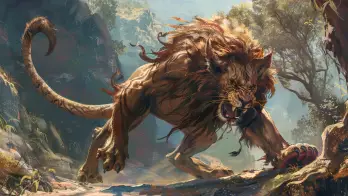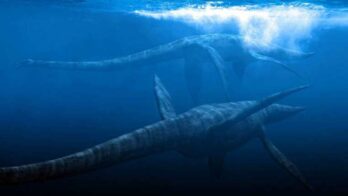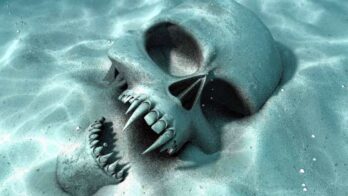Similar to the more famous Loch Ness monster, Morag is said to be a large, serpent-like creature that has been spotted in the depths of the loch.
The legend of Morag dates back centuries, and there have been numerous sightings of the creature over the years.
According to local lore, Morag is said to be a female creature, and some even believe that she may be related to the famous Loch Ness monster.
One of the most famous sightings of Morag took place in 1969 when two men claimed to have seen a large, snake-like creature swimming in the loch. The creature was said to be around 30 feet in length, with a dark, scaly body and a long neck.
The mysterious Loch Morar
Loch Morar is a freshwater lake located in the Scottish Highlands, near the town of Mallaig. It is the fifth deepest lake in Europe, with a maximum depth of 310 meters (1,017 feet) and a surface area of approximately 26.7 square kilometers (10.3 square miles).
The lake is surrounded by mountainous terrain and is fed by several small rivers and streams. The water in the lake is generally cold and clear, with visibility up to 30 meters (100 feet) in some areas.
Despite its depth, the lake is not particularly large, and it is unlikely to sustain a large population of underwater animals. However, it is home to a variety of fish species, including salmon, trout, and pike.
Loch Morar has become famous for the legend of the Loch Morar monster, also known as Morag, which is said to inhabit the lake’s depths.
Could lake monsters exist?
In fact, legends about lake and sea monsters have been around for centuries, with stories of mysterious creatures inhabiting bodies of water appearing in many different cultures and regions worldwide.
While the specific details of these legends vary, they all share a common theme of a large, often serpent-like creature that is said to live in a lake, river, or ocean.
One of the most famous lake monsters is the Loch Ness monster, which is said to inhabit Scotland’s Loch Ness.
The legend of the Loch Ness monster dates back to the early 20th century, and there have been numerous reported sightings and attempts to capture evidence of the creature over the years.
Similarly, Lake Champlain in North America has its own lake monster legend, known as Champ.
Sightings of Champ date back to the 19th century and the creature is described as being around 20-30 feet long, with a serpentine body and a horse-like head.
Other famous lake monsters include Tahoe Tessie in Lake Tahoe, Ogopogo in Lake Okanagan, and the Van Lake Monster in Lake Van.
These legends have become popular tourist attractions in many cases, drawing visitors who hope to glimpse the elusive creatures.
While scientists often dismiss the existence of lake monsters as a myth or a case of mistaken identity, some people continue to believe in the creatures and search for evidence of their existence.
Most of the creatures spotted at Loch Morar and the other areas mentioned above have been described as resembling a plesiosaur, a marine reptile from the Mesozoic era, with a long neck and paddle-shaped limbs.
However, such reptiles should not exist. The last dinosaurs from the Mesozoic era disappeared approximately 60 million years ago.
If plesiosaurs had survived, these creatures would have had to face almost impossible conditions (for example, they would have had to adapt quickly to an aquatic environment much colder than their ancestors lived).
Biologist Roy P. Mackal, who dedicated much of his career to studying lake monsters, argues that Nessie, Morag, and their “relatives” are zeuglodons, primitive whales with a snake-like appearance.
However, this species has been considered extinct for over 20 million years. The idea of the survival of such giant mammals, relics of the prehistoric era, seems too fantastic to be credible.
A terrifying first sighting: a father and son's encounter with Morag
Morag, a legendary creature that haunts the depths of Loch Morar, a freshwater loch located in Scotland’s West Highlands, was first photographed on April 3, 1971, by Ewen Gillies, a local resident.
Gillies, who had lived his entire life in a house overlooking the loch, was accompanied by his 12-year-old son John when they spotted the beast.
Walking down the road from the lakeshore, John alerted his father when he saw an enormous animal approximately half a mile away from shore.
Gillies observed the creature rising about three or four feet from the water, its neck extending and curving slightly towards its head.
The head was scarcely distinguishable from the neck, and the skin was black and shiny. Two or three humps, wet with water, stretched along the animal’s back, which was approximately 30 feet long.
Excited by the sight, Gillies hurriedly ran inside his house, grabbed a camera, and took two photos of the creature from the window of his home before it plunged back into the water.
Although the photographs were unsuccessful, no one in the community accused Gillies of tampering with them, as he was a respected member.
The community was sure that Gillies and his son had seen the creature that would later be named “Morag.”
The name “Morag” is derived from the Gaelic word “Mhorag,” a Celtic language spoken in Ireland and Scotland.
It is believed to represent the spirit of the loch, a mermaid capable of changing its appearance. According to local legends, the creature’s appearance foretells the death of the one who sees it.
Over time, the ancient folklore surrounding Morag faded from memory as the population dwindled.
In the late 19th century, researcher Elizabeth Montgomery Campbell interviewed elderly residents of the area who remembered sightings from their youth. Folklorist R. MacDonald Robertson collected the following account from Alexander Mcdonnell at the beginning of the next century:
A few years ago, I was motoring down the loch from Meuble to Morar landing stage with several school children and others when we reached Bracarina Point; several children excitedly cried out: ‘Look! What’s that big thing up there on the hill?’
The beast was as big as a full-grown Indian elephant; it allowed itself to slip down the rocks and disappeared into the water with a great splash.
Robertson noted that “the monster of Loch Morar has been seen by several persons whose credibility cannot be questioned.”
In her unpublished memoirs from 1940, Lady Brinkman, who had lived on an estate near the loch for nearly five decades, recalled an incident that occurred in the summer of 1895:
One evening around five o’clock, I was sitting and looking when I suddenly spotted a vast silhouette rising from the waters of the loch at a considerable distance.
I drew Theodore and McLaren’s attention and asked them if it wasn’t a motorboat because it seemed to me that it was heading in the wrong direction.
McLaren looked long to the left, where the boat was supposed to appear, then, while I was watching, the object disappeared. Then McLaren said and added that it was well known that it appeared occasionally.
After 1933, Scotland’s two monsters, Loch Ness and Morag, became news topics, generating some of the most important newspaper headlines.
Some eyewitnesses even claimed to see either humps sliding quickly in the water or a creature with a long neck.
Although there are numerous reports, the Morag monster is much less well-known than Nessie, on which researchers’ interest has focused almost uninterrupted for six decades.
Sonar detections, photographs, and the statements of many eyewitnesses have created for the Loch Ness resident monster a fame that Morag cannot even claim.
The 1969 encounter: locals come face to face with the Morag monster
The Morag monster’s most remarkable sighting on record occurred on August 16, 1969, and was widely covered by newspapers worldwide.
The protagonists of this unforgettable event were two locals, William Simpson and Duncan McDonnell, who were returning from a fishing expedition at the northern end of the loch when they heard a splash behind them.
McDonnell was left speechless as he turned around and saw a creature swimming straight toward them.
To their amazement, the monster approached the boat’s edge, briefly paused, and bumped the vessel. While McDonnell was convinced the collision was accidental, he feared the creature’s next move could overturn the boat.
Fearing for their safety, Simpson shut down the boat’s engine and quickly retrieved a gun from the deck. Despite firing a shot at the monster, it appeared unaffected by the impact.
The creature gradually moved away and vanished into the water, ending the encounter, which lasted approximately five minutes.
In retrospect, Simpson reflected on the incident, stating:
I witnessed the creature catch up with us and collide with the boat. The impact threw our kettle, used for heating water, to the ground. I rushed into the cabin to shut off the gas as the water had extinguished the flame.
On my return, I saw my friend attempting to fend off the creature with an oar, but from my vantage point, his efforts were in vain. When the oar broke, I loaded my rifle quickly, firing toward the monster.
Is Morag, the Loch Morar monster, real?
There is no concrete evidence to prove the existence of the Loch Morar monster, Morag. The sightings and stories about this creature are largely based on anecdotal evidence and eyewitness accounts, which can be unreliable.
While there have been many reported sightings of the fabled Loch Morar monster over the years, it’s important to note that there are often more rational explanations for these sightings.
For example, waves, logs, or other natural phenomena could be mistaken for a large, serpent-like creature in the water.
Furthermore, Loch Morar is a very deep and remote lake, which makes it difficult to conduct thorough scientific investigations. As a result, there is no conclusive evidence to support the existence of Morag.






